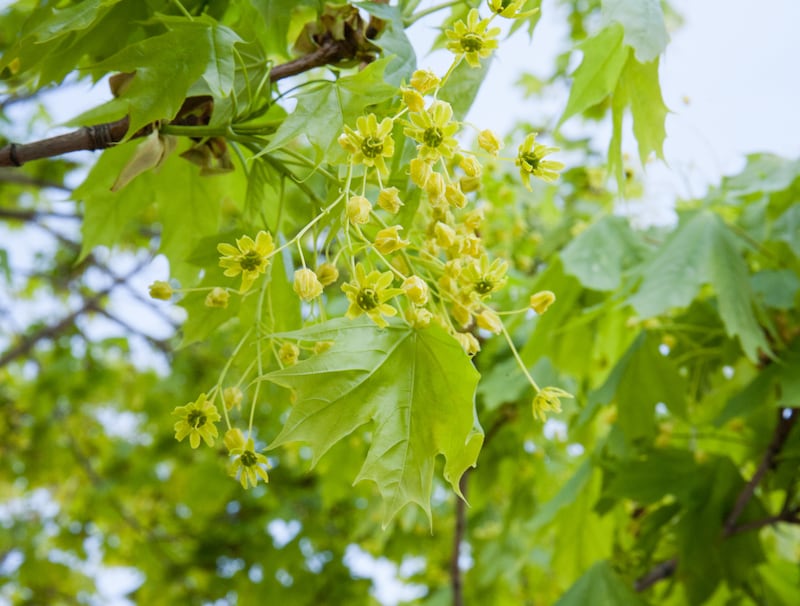Perched on the far western edge of Europe, surrounded by water, Ireland has always been a windy little island, painfully vulnerable to the rain-soaked gales that barrel across the Atlantic ocean and the icy winter storms that sweep in from the east. Talk to any seasoned gardener who lives along our Atlantic coastline and they’ll regale you with stories of trees uprooted and plants regularly snapped in half. One quick look at the wind-sculpted silhouettes of the frontline trees and shrubs that grow in these coastal counties – the doughty hawthorns, the craggy sycamores – tells you all you need to know about the sheer ferocity, persistence and direction of the gales that have shaped them and how it has always been that way.
Except that, just like pretty much everything else about our climate, the nature of wind in this country is changing. In particular, scientists are predicting changes in wind speeds and storm tracks as well as seasonal changes (less powerful in spring, summer and autumn but more powerful in winter, with possibly more storms of greater intensity extending further south over the country).
Exactly how will this affect Irish gardens? Well, a violent winter gale can break branches and cause root rock sufficient to destabilise a large tree or shrub, especially if that same tree or shrub has yet to shed its autumn leaves as is increasingly the case, because of warmer, later autumns. With its weighty crown of foliage acting like the full sails of a ship caught in the midst of a typhoon and its root system made less stable by the effects of heavy rainfall upon the soil, the plant is more easily toppled.
Alternatively, if that violent gale comes in very late winter/spring and is laden with salty sea spray, as is so often the case along the Atlantic coastline, then it can badly sear and desiccate new growth. Ask any gardener living in the west of the country about ‘an gaoth ruadh’ and they will speak with fear and awe of the fierce ‘red wind’ that can leave the foliage of plants bruised, shredded and desiccated, and the soil so laden with salt that those same plants struggle to take in water, causing their leaves to wither and die.
READ MORE

Salty gales aside, strong winds can cause other problems in our gardens and allotments by lowering the temperature, stunting or limiting growth, blighting seedlings, scorching or chilling leaves, reducing harvests and damaging flowers with consequences that are more than just ornamental (no blossom on an apple tree, for example, means no fruit). Those same strong winds can also cause soil erosion, loss of soil nutrients and negatively impact a soil’s ability to hold water.
A very windy garden or allotment also offers less shelter and useful habitats for wildlife with a consequent reduction in biodiversity as well as productivity (pollinating insects, for example, will struggle to fly). Strong winds can also do considerable damage to built garden structures, from glasshouses and polytunnels to fences, trelliswork and pergolas. Viewed solely from a humancentric point of view, windy gardens are also less comfortable places to be. Given the choice of an exposed plot or a sheltered one, for example, most of us would plump for the latter.
This is not to say that an entirely wind-free garden is the ideal; gentle winds help to dry winter-wet soils, reduce the risk of certain plant diseases and help with seed dispersal. They also boost plant resilience by stimulating the release of the plant hormone known as auxin, which helps the plant to fortify itself against any possible future damage by stimulating the growth of supporting cells. So, for example, the stems of young seedlings exposed to a gentle wind will naturally become thicker, stronger and more resilient, an effect that gardeners can replicate with seedlings grown under cover by gently brushing their hands over them a couple of times a day.
But these more benign breezes aside, how do we protect our gardens, our plants (and ourselves) from the worst of violent gales?
The answer is, as usual, a multifaceted one. One of the most effective solutions is to plant a windbreak (typically a sturdy hedge or row of trees) or a shelterbelt (a taller, wider, denser version suitable for larger gardens, using taller trees and shrubs), focusing on resilient, nature-friendly species selected for their suitability for the site and cleverly positioned to filter the worst of prevailing winds. Traditionally used in exposed gardens as the first line of defence, these do a marvellous job of slowly but surely creating a sheltered microclimate where more vulnerable plants can grow to their leeward side with relative comfort. Much more effective than an impermeable wall or fence (rather than filtering the wind, both of the latter redirect it in ways that cause damaging eddies), living windbreaks and shelterbelts can reduce the speed and impact of strong winds by as much as 60 per cent to a distance of roughly 10 times their height.

Suitable windbreak and shelterbelt species for exposed Irish coastal gardens include Ebbinge’s silverberry (Eleagnus x ebbingei ‘Compacta’); the rugosa rose (Rosa rugosa); the daisy bush (Olearia traversii and Olearia haastii); fuchsia (Fuchsia riccartonnii); pyracantha (Pyracantha coccinea); sea buckthorn (Hippophae rhamnoides); Griselinia littoralis; blackthorn (Prunus spinosa); hawthorn (Crataegus monogyna); Carrierei Hawthorn (Crataegus lavalleei Carrierei); holly (ilex aquifolium); holm oak (Quercus ilex); Turkey oak (Quercus cerris); Darwin’s berberis (Berberis darwinii); sycamore (Acer pseudoplatanus); whitebeam (Sorbus aria); field maple (Acer campestre); Scots pine (Pinus sylvestris); dwarf pine (Pinus mugo) and alder (Alnus glutinosa), almost all of which are available to buy at this time of year as budget-friendly bare-root or root ball specimens. Many but not all of the above are also suitable for exposed but colder inland gardens.
In new, very exposed gardens, these windbreaks and shelterbelts can themselves initially struggle when first planted but will establish much more quickly if you can protect the young plants with windbreak netting until they get going (available from good garden centres and online suppliers such as fruithillfarm.com and quickcrop.ie. Available in different weights (the higher the weight, the more effective) and in different widths (100cm, 150cm, 200cm), this long-lasting, ultra-durable plastic netting needs to be secured tightly and tautly with galvanised wire to the windward side of sturdy timber posts cemented firmly into the ground, leaving a slight gap at the bottom to reduce the full impact of strong winds on the supporting posts.

To choose the best place to situate a windbreak or shelterbelt in your garden or allotment, take the time to carefully study the direction of prevailing winds, bearing in mind that larger gardens on exposed, hilly sites may need a series of windbreaks or shelterbelts to offer full protection. Also bear in mind their eventual height and spread. As precious as it is, shelter almost inevitably comes at the cost of light (and vice versa), a delicate balancing act that needs to be carefully negotiated to give the very best of both worlds.
This week in the garden
Use lengths of garden twine to gently tie in any long, dangling shoots of wall shrubs and climbing plants to protect them from being damaged by winter gales. This is also a good time to check tree ties to make sure that they’re not too tight and aren’t damaging the trunks by cutting into them, a process known as ‘girdling’ which can slowly kill even well-established young trees. Bear in mind that tree stakes should always be placed to the windward side of the trunk to prevent damage.
Many gardeners wonder if it’s really necessary to lift dahlia tubers in late autumn in order to safely overwinter them under cover in a shed, a laborious, time-consuming and messy job that no one looks forward to. If your garden is a cold and/or wet one prone to waterlogging, then it’s definitely the safest option as the fleshy tubers can be badly damaged or killed by sitting in cold wet soil over winter. But in warmer, free-draining gardens, it’s generally fine to cut the plants back and leave the tubers in the ground under a protective winter mulch of straw, dead bracken or well-rotted manure.
Dates for your diary
Thursday, November 24th (8pm), Garryduff sports centre, Cork, T12ER22, ‘Plant Hunter and Gardener with Passion’, a talk by the English horticulturist, author and plant hunter Tom Hart Dyke, of Lullingstone Castle, on behalf of Cork Alpine Hardy Plant Society, all welcome.
Monday, 28th November (8pm), Kilternan parish centre, Enniskerry Road, Kilternan, Co Wicklow, D18 ET99, ‘How to create seasonal, sustainable, natural Christmas arrangements using foliage and seed heads foraged from the garden and the wild hedgerows”, a talk and practical demonstration by Fionnuala Fallon on behalf of Kilternan Gardening Club, all welcome.
Calling all garden designers, the closing date for applications for show garden designers for Bloom 2023 is Friday, December 2nd. For more information visit bordbiabloom.com/participate.















